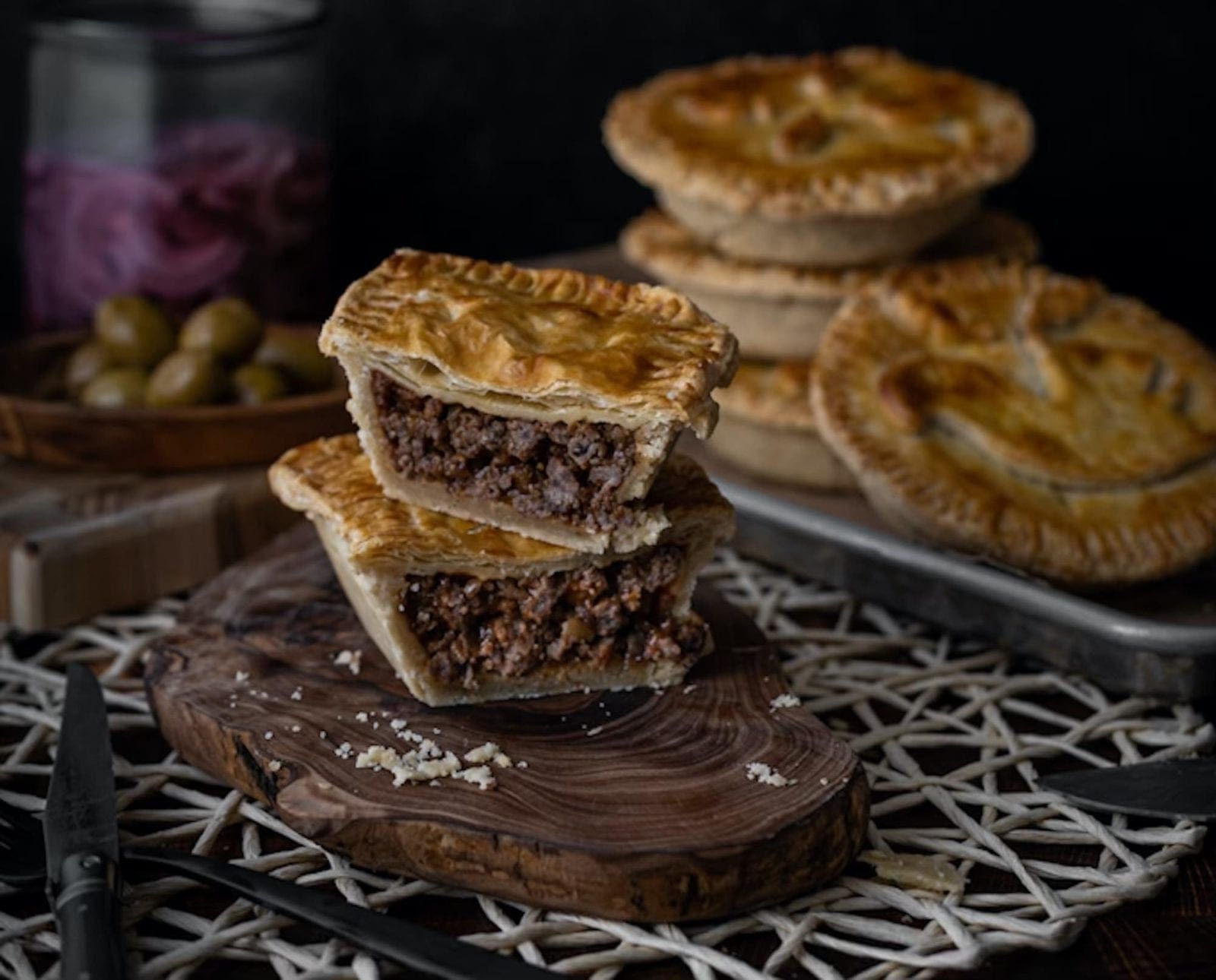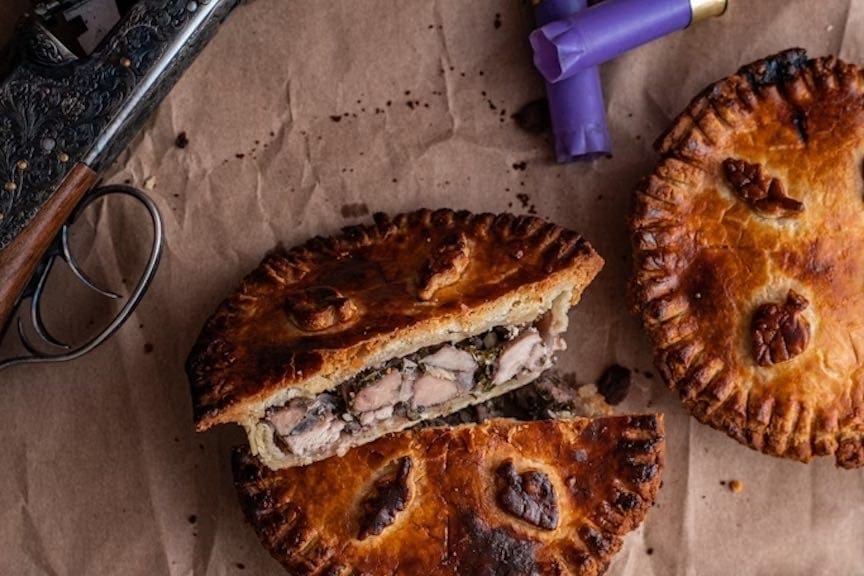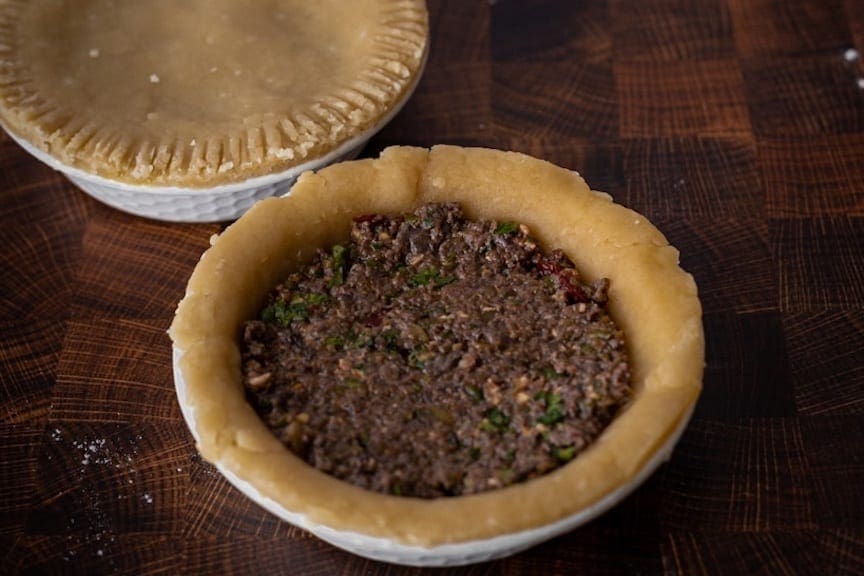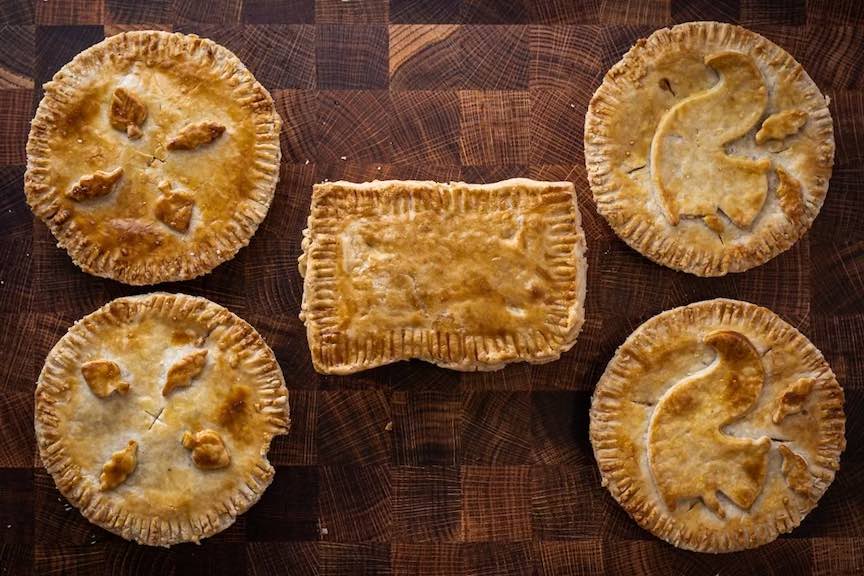Home » Small Game Cooking » How to Make Game Meat Pies – Three Classic Upland Recipes
How to Make Game Meat Pies – Three Classic Upland Recipes

Simon Tiedge was born and raised in a small town…
Say bye-bye, Miss American Pie, and try these three recipes for hearty, savory, meaty upland game pies perfect for a winter day
It is winter in Minnesota, and it’s a cold one! There is nothing better than some serious comfort food to warm you up, or to feed you on a frigid, late-season small game hunt. Meat pie, my favorite kind of pie, is the dish of choice for this occasion. My freezer is filled with random memories from the last five months of the hunting season and three of those vacuum-sealed memories make their way into the kitchen with me. I’m making game pies.
Mentioning pie in this neck of the woods will get folks thinking of all kinds of sweet treats, with apple pie being on top of the list. After all, apple pie is as American as blue jeans, the Fourth of July, and shooting timberdoodles with a Fox Sterlingworth. But these pies won’t be of the sweet kind.
Pies are thought to have originated in Ancient Greece and started as a hearty, meaty dish. Later, they became a favorite in medieval England where they contained mainly fowl and upland game birds. One of my pies is an homage to traditional English game pies, just much smaller than the impressive centerpiece of a raised game pie that you might be imagining–more of an individual hand pie. I am using a South Dakota ringneck for this baked deliciousness. Other British classic pies includes Shepard’s pie.
The second pie is inspired by my travels to Australia where I stuffed my face many times with gravy-and-minced-meat-filled pies at a rugby game or on “smoko” (short work break). Unlike the others, the filling in this pie gets cooked ahead of time, and the lid is usually made of puff pastry. Wisconsin fox squirrel is the meat of choice for this dish.
The last pie is inspired by one of my favorite dishes, chile verde. It is full of flavor and has a decent amount of spice. It’s the perfect pie to wrap up in a towel and take with you on a long hunting trip to give you some heat on a midday meal. The protein for this pie was shot in September in North Dakota on my first sharptail hunting excursion.
A word on hot-water crust
All three of these recipes use a very traditional meat pie crust. It comes together very easily but can be a little tricky to handle if you let it get too cold. So work swiftly.
Hot-water crust is traditionally made with lard, but you can use any rendered fat like duck or pheasant. If you don’t have either of those, you can always substitute with butter or ghee.
Hot Water Pastry
Makes dough for 4 individual pies, or one of the following meat pie recipes
Ingredients
- 675 g (24oz) all-purpose flour
- 75 ml (1/3 cup) milk
- 225g lard, duck fat, or butter
- 3/4 tsp salt
Method for making the pastry dough
- Heat up milk with lard in a small saucepan until the fat is completely melted
- In a large bowl, mix together flour and salt
- Add milk-fat mixture and stir with wooden spoon (very hot in the beginning) until the dough comes together.
- Move dough onto lightly-floured surface and knead until smooth

Pheasant Game Pie
Makes 4 individual pies
Ingredients
- 4 pheasant breasts, cubed
- 2 shallots, minced
- 2 cloves of garlic, minced
- 2 tsp cumin
- 1/4 cup port wine, Madeira, or red wine
- 1/8 tsp ground cloves
- 1 1/2 tsp salt (or to taste)
- 1 egg yolk mixed with about 1 fl oz of milk for egg wash
- Freshly ground pepper
Method for making Pheasant Game Pie
- Preheat oven to 350 degrees Fahrenheit
- Mix all ingredients except the egg wash together in a bowl and allow to marinate until the dough is prepared
- Split off 1/3 of the pie dough and set aside for the lids
- Split the rest of the dough into 4 equal parts
- Shape each piece of dough into a ball and, using a rolling pin, roll it into a circle that is about 2 inches bigger in diameter than your pie dish (I use small 5-inch ceramic dishes). The crust should be about 1/4 inch thick.
- Line each greased pie dish with the dough. You can squeeze it up the sides and over the rim of the dish with your thumbs.
- I always fry up a tiny bit of my pie fillings and taste them to see if I got the spices right. This would be the time to do that.
- Fill the pies with the pheasant mixture
- Roll out the lids
- Brush egg wash onto the rim of the pie and place the lid on top. Cut around the pie dish with a sharp knife to take off excess dough. Seal the lid to the crust by squeezing it with a fork.
- You can use any leftover dough to make small decorations either by hand or with a cookie cutter. “Glue” them to the top of the pie with the egg wash.
- Brush the top with egg wash and put into the preheated oven for about 30 minutes
- If you use ceramic dishes like I do, take the pies out of the oven and let them cool just slightly. Take the pies out of the dish and put them on a baking sheet or directly on the rack back in the oven for 10 minutes to firm up the crust.
- Pie can be eaten warm or cold. I prefer cold with some mustard and pickles.
Aussie Squirrel Pie
Makes 4 individual pies
Ingredients
- Oil, lard, fat or whatever you prefer for pan frying
- 1 red onion
- 4 squirrels, deboned and minced
- 2 strips bacon
- 1 cup venison or beef stock
- 1 tbsp cornstarch
- 1 6oz can of tomato paste
- 2 tbsp Worcestershire sauce
- 2 tbsp BBQ sauce
- 2 sheets puff pastry
- 1 egg yolk mixed with about 1 fl oz of milk for egg wash
Method for making Aussie Squirrel Pie
- Preheat oven to 350 degrees Fahrenheit
- Heat fat in a sauce pan over medium heat and cook onions until soft
- In the meantime, mince the squirrel meat and bacon in a food processor
- Add minced meat mixture to pan and cook until it is nicely browned
- Stir in tomato paste and cook for a couple of minutes
- Mix cornstarch with 1 tbsp of stock and deglaze pan with the remaining stock
- Add Worcestershire sauce, BBQ sauce and cornstarch mixture, then simmer for about 10 minutes or until the sauce gets thick. Allow this to cool.
- Split the pie dough into 4 equal parts
- Shape each piece of dough into a ball and, using a rolling pin, roll it into a circle that is about 2 inches bigger in diameter than your pie dish (I use small 5-inch ceramic dishes). The crust should be about 1/4 inch thick.
- Line the greased pie dish with the dough. You can squeeze it up the sides and over the rim of the dish with your thumbs.
- Fill the pie with the minced meat mixture.
- Cut out the lids from thawed puff pastry sheet
- Brush egg wash onto the rim of the pie and place the lid on top. Cut around the pie dish with a sharp knife to take off excess dough. Seal the lid to the crust by squeezing it with a fork.
- Brush the top with egg wash and put into the preheated oven for about 20 minutes
- If you use ceramic dishes like I do, take the pies out of the oven and let them cool just slightly. Take the pies out of the dish and put them on a baking sheet or directly on the rack back in the oven for 5-10 minutes to firm up the crust.
- Take out and let them cool down just a bit before eating

Spicy Chile Sharpie Pie
Makes 4 individual pies
Ingredients
- 4 sharp-tailed grouse breasts, cubed
- 1 slice bacon
- 2 cans of mild green chiles
- 1-2 jalapeños, finely chopped
- 1 lime, juiced
- 1/4 cup chopped cilantro, finely chopped
- 1 1/2 tsp salt
- 1/4 tsp cinnamon
- 1/8 tsp ground cloves
- 1 egg yolk mixed with about 1 fl oz of milk for egg wash
Method for making Spicy Chile Sharpie Pie
- Preheat oven to 350 degrees Fahrenheit
- Mince sharptail cubes and bacon in a food processor. I prefer it more on the minced side than finely ground.
- Mix all ingredients except the egg wash together in a bowl and allow to marinate until the dough is prepared
- Split off 1/3 of the pie dough and set aside for the lids
- Split the rest of the dough into 4 equal parts.
- Shape each piece of dough into a ball and, using a rolling pin, roll it into a circle that is about 2 inches bigger in diameter than your pie dish (I use small 5-inch ceramic dishes). The crust should be about 1/4 inch thick.
- Line the greased pie dish with the dough. You can squeeze it up the sides and over the rim of the dish with your thumbs.
- I always fry up a tiny bit of my pie fillings and taste them to see if I got the spices right. This would be the time to do that.
- Fill the pie with the minced meat mixture
- Roll out the pie lids
- Brush egg wash onto the rim of the pie and place the lid on top. Cut around the pie dish with a sharp knife to take off excess dough and seal the lid to the crust by squeezing it with a fork.
- You can use any leftover dough to make small decorations either by hand or with cookie cutter. “Glue” them to the top of the pie with the egg wash.
- Brush the top with egg wash and put into the preheated oven for about 30 minutes
- If you use ceramic dishes like I do, take the pies out of the oven and let them cool just slightly. Take the pies out of the dish and put them on a baking sheet or directly on the rack back in the oven for 10 minutes to firm up the crust.
- Take out and let cool a little before eating

Simon Tiedge was born and raised in a small town in Germany, where hunting access is limited, but wild game can be bought in stores and enjoyed in restaurants. Preparing food has been a passion of his for a long time, and only grew more important to him when he moved to Minneapolis, Minnesota in 2011. He began searching for ingredients and foods that he had grown up with in Germany and had enjoyed during his travels abroad. When he couldn’t find some things he took matters into his own hands and started baking bread and making cheese, but still the wild game he loved had eluded him. In 2019, with his new hunting dog Shooter out front, he closed the circle to supply his own meat by hunting the public lands of the USA. Today Simon lives in a small town in Minnesota with his wife and 2 dogs and creates wild game meals out of all the memories that fill his freezer.




I see that in the Aussie Squirrel Pie to use red onion in the ingredients but then it doesn’t show how to use it in the directions. How do you process it for this pie?
Hey Andrew, it’s in step number two. You fry them in the pan till they are soft just before adding the meat.